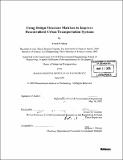Using design structure matrices to improve decentralization urban transportation systems
Author(s)
Dunn, Travis P
DownloadFull printable version (6.804Mb)
Alternative title
Using DSMs to improve decentralization urban transportation systems
Other Contributors
Massachusetts Institute of Technology. Dept. of Civil and Environmental Engineering.
Advisor
Joseph M. Sussman.
Terms of use
Metadata
Show full item recordAbstract
Management of large, complex, urban transportation systems involves numerous stakeholders due to the decentralized ownership and operation of distinct pieces of the physical network. In order to deliver better service to users, many urban regions are adopting technological and operational solutions, both of which necessitate interaction among the decentralized actors. This research applies a systems engineering analysis technique-the design structure matrix (DSM)-in order to improve the efficiency and effectiveness of decentralized organizations involved in urban transportation as they deploy technology and attempt to integrate their operations. DSMs alone provide advantageous, straightforward system representation platforms. Furthermore, clustering algorithms can be applied to DSMs in order to identify potential opportunities to improve the institutional structure of the decentralized system of organizations. We propose DSM representation and clustering as valuable methods for urban regions to identify organizational structures that facilitate both technology deployment through efficient utilization of resources and more effective operations through re-characterizaton of organizational linkages.
Description
Thesis (S.M.)--Massachusetts Institute of Technology, Dept. of Civil and Environmental Engineering, 2005. Includes bibliographical references (p. 129-133).
Date issued
2005Department
Massachusetts Institute of Technology. Department of Civil and Environmental EngineeringPublisher
Massachusetts Institute of Technology
Keywords
Civil and Environmental Engineering.